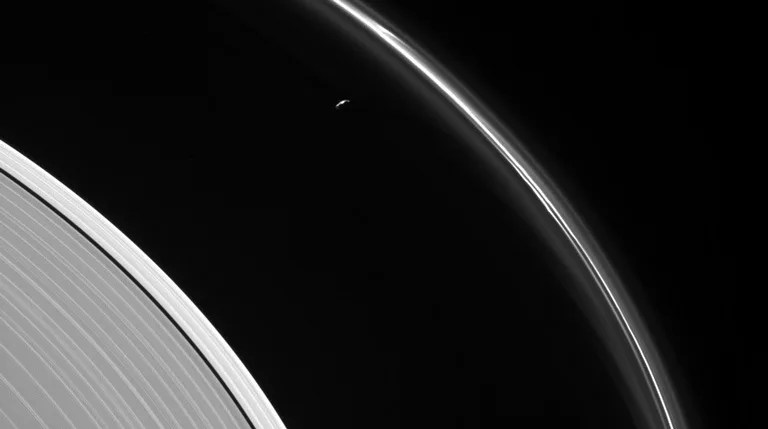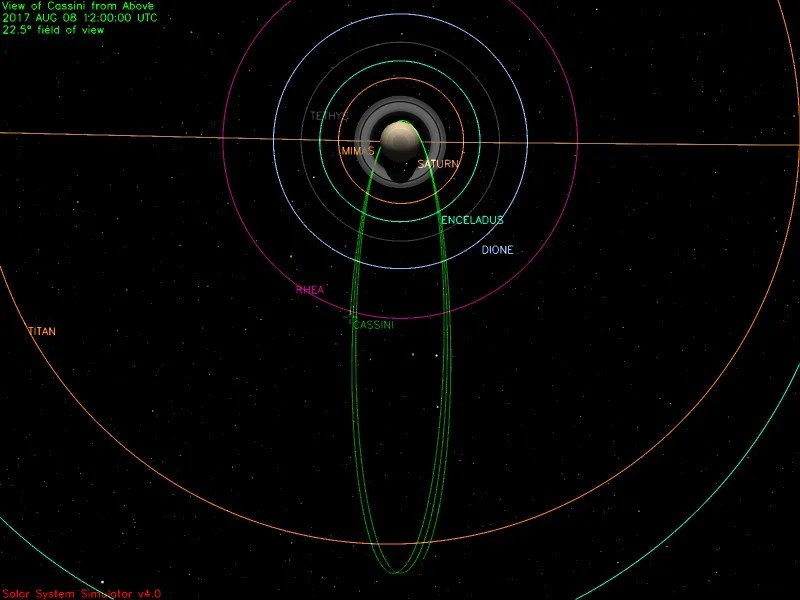7 min read

On Monday of this week, Cassini successfully completed its 17th ring-plane passage between Saturn and its innermost rings, out of a total of 22. This pass was the final one to occur in the region about midway between the sensible edges of the D ring and the atmosphere. Cassini’s five remaining proximal plunges will be much closer to Saturn; in fact, they will be close enough to directly sense and measure some of the high, thin parts of the gas giant itself.
The mission is drawing to a close after a most productive and exciting adventure that spans two decades. An article featured this week looks back on the highly complex undertaking that is Cassini-Huygens. It may be seen here: /news/13091/nine-ways-cassini-matters-no-8.
Wednesday, Aug. 2 (DOY 214)
Having catapulted past periapsis the day before, Cassini was now climbing away from Saturn, and early today had reached about as far from the planet as the icy moon Rhea, half a million kilometers out. By the end of the day, still slowing, the spacecraft was approaching the orbit of Saturn' largest moon Titan.
For nearly 13 hours today, Cassini's Imaging Science Subsystem (ISS) had its telescopes trained on Saturn's curiously active moon Enceladus. The Composite Infrared Spectrometer (CIRS), the Visible and Infrared Mapping Spectrometer (VIMS), and the Ultraviolet Imaging Spectrograph (UVIS), all of which share the same hard-mounted pointing of their optics, also took data. This observation was part of a campaign to monitor and track Enceladus's plume of ejecta, looking for long term variations. Enceladus was on the opposite side of the ring-world and largely backlit, a lighting condition that makes material in the plume clearly visible. The viewing geometry is illustrated here. To see how these images actually came out, see the raw image site on Cassini’s web.
When this observation was done, Saturn's large icy moon Dione had swung into a position to be backlit by the Sun. In a search for any possible plumes or traces of an atmosphere, ISS led the other optical instruments in a one-hour examination of that moon's environs.
A story about Cassini's final planned rocket burn last July 15 was featured today: /news/13096/one-final-burn.
Thursday, Aug. 3 (DOY 215)
From a low-elevation angle below Saturn's ring system, ISS led the other optical instruments in observing the rings for nine hours, while they were sunlit from behind, that is, at a high-phase angle. This geometry is favorable for viewing the rings’ faint components. Next, CIRS and UVIS targeted the ansa of Saturn's narrow, dusty F ring for another nine hours, to look for variations in physical properties among this rings' particles.
Friday, Aug. 4 (DOY 216)
Having climbed out past the orbit of Titan today, Cassini swung through apoapsis and began another orbit. Orbit #287 is the 17th of Cassini's 6.5-day proximal orbits.
The huge moon was around on the other side of Saturn, in its 16-day orbit of the planet. But the next time Cassini comes out this far, Titan will be nearby enough to sap the precise amount of momentum from Cassini to lower the spacecraft's periapsis altitude into the upper reaches of Saturn's high, thin atmosphere. Then, each of the five remaining dives will be around that height, until Titan meets up again with Cassini on September 11, just before apoapsis. That flyby will induce a fiery atmospheric entry on the next dive.
The blue star Kappa Orionis, the "right knee" of Orion, slipped out from behind Saturn today, and UVIS was watching. During this hour-long egress-occultation observation, UVIS was able to probe Saturn's atmosphere in the north-polar region, home to the feature dubbed the "hexagon" and to an intense storm centered on the planet's north pole.
Finally today, ISS led the other optical instruments in a 9.3-hour observation of Saturn's rings at fairly high-phase illumination. The rings' sunlit side was visible, now that Cassini was on its way inbound again.
Saturday, Aug. 5 (DOY 217)
Still pointing at the rings, VIMS spent 6.7 hours making a mosaic of one half of them, with CIRS and UVIS riding along. Next, CIRS began a 16-hour stare at the rings, not simply because they are beautiful, but to measure their composition and structure. The other optical instruments participated, and indeed ISS did capture some beautiful views.
Sunday, Aug. 6 (DOY 218)
Several Cassini scientists attended the Asia Oceania Geosciences Society (AOGS) meeting in Singapore today through Aug. 11. They presented the latest science results from Cassini’s Grand Finale.
Monday, Aug. 7 (DOY 219)
Another week, another proximal plunge between Saturn and its rings: Cassini again made a rapid trip over Saturn's north pole, down south through the gap on the day-side of Saturn, and then began climbing away from below the ring plane, around to Saturn's dark night side.
UVIS again studied the planet's aurora, both at the north pole on the way in, and then at the south pole on the way out. In all, UVIS spent more than 26 hours with these observations. On the way inbound, ISS led another two-hour propeller (https://go.nasa.gov/2mMff0f) observation, and VIMS led a composition study of the rings' sunlit side for 2.7 hours.
All the while, Cassini's direct-sensing instruments were taking advantage of their proximity to Saturn and its rings, before, during, and after today's periapsis passage. The Ion and Neutral Mass Spectrometer (INMS) surveyed the atmospheric and ionospheric thermal structure, while the Magnetospheric Imaging Instrument (MIMI) and the Radio and Plasma Wave Science (RPWS) instrument examined Saturn's inner magnetosphere, helped measure impacts from particles of dust, and obtained high-resolution data on plasma waves at the magnetic equator. The Magnetometer (MAG) made internal field measurements, and the Cosmic Dust Analyzer (CDA) sampled the sparse dust in the environment.
A beautiful image featured today shows part of Saturn's broad A ring, the narrow, bright F ring, and the little moon Prometheus which perturbs that ring once every 14.6 hours. The image was taken on approach to Cassini's fourth proximal plunge: /resources/17718.
Tuesday, Aug. 8 (DOY 220)
Closing out the week, ISS began a 29-hour observation of Saturn's tiny irregular moon Kiviuq, which was described in last week's report, on July 28.
NASA's Astronomy Picture of the Day features a digital composite made from Cassini's images of the rings by a blogger with the Planetary Society: https://apod.nasa.gov/apod/ap170808.html.
The DSN communicated with and tracked Cassini on seven occasions this week, using stations in California, Spain, and Australia. A total of 24 individual commands were uplinked, and about 1,450 megabytes of science and engineering telemetry data were downlinked and captured at rates as high as 142,201 bits per second.
Wrap up:
Cassini is executing its set of 22 Grand Finale Proximal orbits, which have a period of 6.5 days, in a plane inclined 61.8 degrees from the planet's equatorial plane. Each orbit stretches out to an apoapsis altitude of about 1,272,000 km from Saturn, where the spacecraft's planet-relative speed is around 6,000 km/hr. At periapsis, the distance shrinks to about 2,500 km above Saturn's visible atmosphere (for reference, Saturn is about 120,660 km in diameter), and the speed is around 123,000 km/hr.
The most recent spacecraft tracking and telemetry data were obtained on Aug. 8 using the 70-meter diameter DSN station in Spain. The spacecraft continues to be in an excellent state of health with all of its subsystems operating normally except for the instrument issues described at https://saturn.jpl.nasa.gov/anomalies.
This illustration shows Cassini's path up to mid-day Aug. 8: https://go.nasa.gov/2qCIbIC.
The countdown clock in Mission Control shows 37 days until the end of the Mission.
------------------------
This page offers all the details of the Mission's ending: <https://saturn.jpl.nasa.gov/mission/grand-finale/overview/>
------------------------
Milestones spanning the whole orbital tour are listed here:
<https://saturn.jpl.nasa.gov/mission/saturn-tour/tour-dates/>
------------------------
Information on the present position and speed of the Cassini spacecraft may be found on the "Present Position" page at:
<https://saturn.jpl.nasa.gov/mission/saturn-tour/where-is-cassini-now/>
------------------------
To unsubscribe from Cassini Spacecraft Updates or to subscribe with a different email address, visit:
<http://saturn.jpl.nasa.gov/news/mailinglistsignup/>
------------------------
For comments and questions, please contact Cassini Public Engagement at:
<http://saturn.jpl.nasa.gov/feedback/>
------------------------








